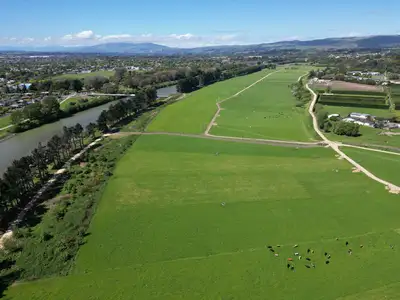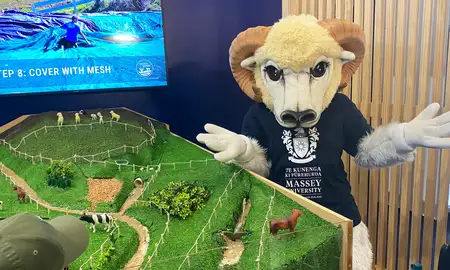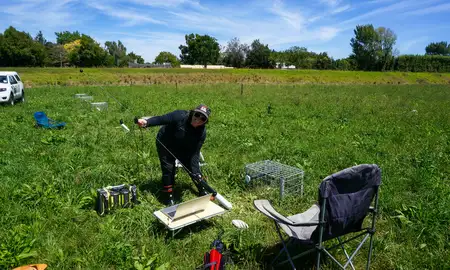
Elisa lights up when asked what she enjoys most about her role as a Te Kunenga ki Pūrehuroa Massey University dairy herd manager.
“I love cows, they are so much fun. I can be outside all day. I also like the challenges that come with my job. Every day is different!”
A large part of Elisa’s job is managing the dairy herds that are part of the Whenua Haumanu programme. Led by Massey, Whenua Haumanu is Aotearoa New Zealand's most comprehensive research programme on the effects of contemporary and regenerative pastoral practices, and the cornerstone of the Ministry for Primary Industries’ (MPI) portfolio of regenerative agriculture projects. Massey researchers are exploring farming practices across both standard and diverse pastures on research sites at the university’s Manawatū campus, including the Dairy 1 farm and the Pasture and Crop Research Unit.
Dairy 1 is one of Massey’s two commercial dairy farms. It borders the Manawatū River, within the Palmerston North City boundary. The 143 hectare (120 hectare effective) farm is currently milking 258 cows on a once-a-day system. It sits on relatively coarse-textured alluvial soils that are free-draining and high in natural fertility, but prone to summer droughts.

At the start of the Whenua Haumanu programme, 36 hectares of Dairy 1 was divided into three farmlets to research the differences between contemporary and regenerative management, with standard and diverse pastures. Elisa assists with the additional work that comes with running the farmlets.
The programme, which runs for seven years, is approaching its third dairy season. The programme is investigating the effects of pasture and management practices on the milk production, animal health, soil properties, pasture properties, nitrogen and greenhouse gases produced.
“The first year we had 24 cows per farmlet. This has increased to 30 cows this year. Basically, we’re measuring everything scientifically to assess the pasture, soil and the resulting impacts on the production of the herds,” Elisa says.
"As the herd manager, one of the most obvious day-to-day observations I’ve noticed in the diverse pasture is the peaks, in terms of the pasture production, at different times of the year. I have to feed out supplements to different herds at different times because the different pastures are growing at different rates. The pastures also look very different from each other; diverse pastures are quite stalky. They are also longer, so when you cut bales from them, making silage can be challenging because it is often damper.
"We do this research for the farmers, so they don't have to experiment themselves. They can take our results and do what works for them. The hope is that we can make recommendations and improvements to benefit farmers."
Early results from the programme indicate that there are no negative impacts on production or animal health by feeding a diverse pasture. In fact, at some times of the year the diverse pasture herd actually produced more milk than the contemporary herd. But over the total season there was no real difference in total milk yield. Researchers are also exploring fatty acid compositions in the milk from the different herds and their processing and sensory characteristics.
Last year, the farm suffered significant flooding from weather events. Despite this, Elisa is happy that the pasture appears to have recovered well. There have also been some early indications that the diverse pasture may be more drought resistant, as anecdotally the diverse paddocks remained ‘greener’ than the standard pasture over summer. However, it is still too early to draw any firm conclusions.
"As a current part-time agricultural science student, it is interesting to be a part of the study of differences between contemporary farming and regenerative farming,” Elisa says.
“I often consider what I would do if I owned a farm in the future. It’s hard to decide, but I think I would have different pastures and crops to have a lot of dry matter at different times of the year. This project is good for me to learn about what I believe in and which principles I want to put it in practice down the line. Massey is a great place to learn with significant expertise. I can learn from everyone around me, it is always interesting and there is so much going on.”
The Whenua Haumanu programme reports monthly via the Massey website on the current activity within the programme and results are released as they become available. For more information, click here.
Whenau Haumanu
This seven-year programme brings together universities, Crown Research Institutes and industry partners to assess the suitability and relevance of regenerative agriculture in New Zealand.
The programme is investigating the differences between grazing a standard pasture (ryegrass and white clover mix) compared to a diverse pasture mix. At the start of the programme, the diverse pastures were sown with 18 different types of grasses, legumes and herbs. The programme investigates two different management styles, regenerative and contemporary, via a series of farmlets. Each of the research farmlets on Massey’s Dairy 1 Farm is running as a self-contained unit to explore different aspects of the research. Every individual farmlet consists of 13 paddocks, ranging from 0.6 to 1.2 hectares, which are evenly distributed across the farm and across the different soil types - alluvial soils, ranging in texture from loamy sand to silt loam.
Contemporary farmlets are managed according to DairyNZ guidelines, while regenerative farmlet management implements a range of practices that align with the principles of regenerative agriculture. These include longer rest periods between grazing, higher post-grazing residuals, reduced synthetic fertilizer inputs and the use of amendments that aim to support soil microbial function.
Related news
Research in action: Connecting campus to community at Fieldays® 2024
With a brand new site, we are excited to be back at Fieldays® for another year, focusing on community relevant collaborative research in the food and fibre industry.

Empowering tomorrow’s scientists by inspiring today’s teachers
Driven by her passion for science, Feilding Intermediate School teacher Jiselle Rider is spending six months with the university, enhancing her professional growth and advancing the science curriculum at her school through the Te Apārangi Royal Society’s Science Teaching Leadership Programme .

Whenua haumanu – nurturing the land through exploring pastoral farming
Strong local and national interest in regenerative farming saw close to 200 people attending an on-farm field day on 28 November, the largest turnout for a farm event at Massey University in 20 years.
